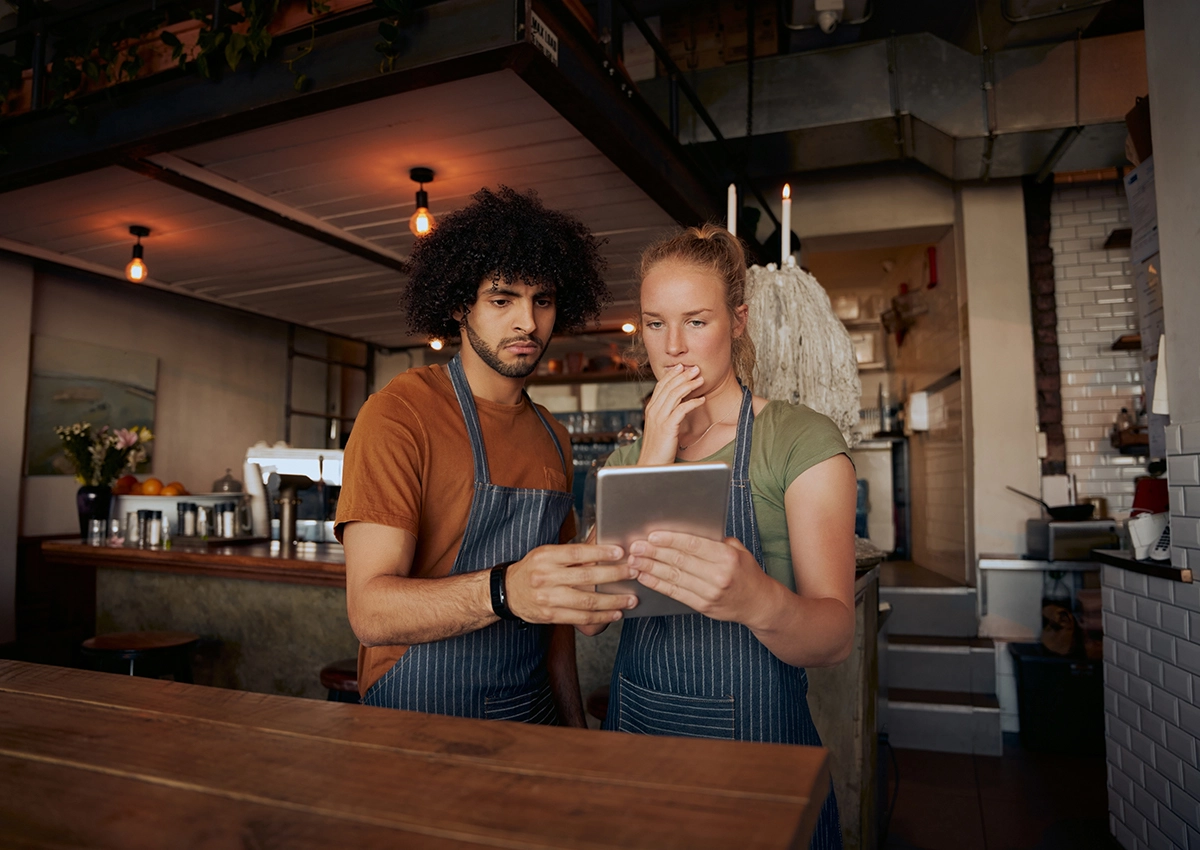Tableside ordering systems are set to revolutionize how diners interact with your restaurant. Not only that but with their powerful data integrations and flexible formats, they’ll change how you run your business.
Implementing a tableside ordering system doesn’t have to be complicated, but there are inherent challenges you’ll have to overcome. Yes, they’ve become the norm, but they should also enhance your business and improve the customer experience.
Today, we’re looking into the common challenges restaurant owners face during the early stages of implementing a tableside POS system. Hopefully, our decades of experience in the dining space will help you navigate the changing waters.
We will cover:
- Decoding the demand for digital table ordering in modern restaurants
- Technical integration challenges
- Staff training and adaptation
- Customer acceptance and usability
- Financial considerations
- Security and privacy concerns
- Maintaining the human touch
- Continuous improvement and feedback
Let’s go!
Decoding the demand for digital table ordering in modern restaurants
Anytime there’s a dramatic shift in the way we do business, the first question to ask is a simple one.
Why?
The restaurant industry’s dramatic shift to digital tableside ordering systems is undeniable. But the reasons why may surprise you.
Consumer expectations
Over the last several years, there’s been mass adoption of cloud-based and app-based ordering in restaurants. In 2023, over 80% of restaurants adopted a digital ordering system to enhance the customer experience. Nearly 60% of diners expect online ordering, and restaurants that don’t adopt it miss out on future business.
One of the biggest drivers behind this shift is consumer behavior. Statistics from 2024 show that 84% of US consumers enjoy using self-service kiosks with 66% preferring them to staffed checkouts. Implementing cloud-based POS systems in dining only makes sense.
Tableside ordering gives consumers control over their own experience. If you use kiosks at your tables, your diners can order and pay when they’re ready. They don’t have to wait for a server, and they don’t have to feel rushed to cash out at the end of their experience.
Market trends fueling adoption
Staffing shortages are one of the most influential market trends in the restaurant industry, fueling the adoption of new tech. From automated ordering systems to streamlined kitchen processes, restaurants are leveraging technology to compensate for reduced manpower. Moreover, the shift towards remote work in other industries has intensified competition for labor, further exacerbating staffing challenges in the restaurant sector.
Tablet-based POS systems increase how quickly orders are placed and fulfilled. Diners have come to expect this kind of efficiency, and it’s a win-win because of how these systems impact your bottom line. Most systems give you access to real-time data about your inventory and integrate with business apps that help you with restaurant management duties. Scheduling, ordering, and payroll just got easier.
Impact on restaurant dynamics
When you implement tableside ordering systems in your establishment, you take control of the flow in your space. Systems like CAKE POS allow you to bring nearly all of the functions of your restaurant into one workflow. You can manipulate where tables are placed, use servers or kiosks, change menus and prices, and improve service times.
By removing paper from your ordering process, tablet-based POS systems reduce your environmental impact. Data from your customers can help shape future menus and adapt to staffing needs on a dime. You’ll also have the power to explore new revenue streams. Direct online ordering, merchandise sales, and tickets to special events are easily managed by your new POS.
It’s easy to feel nostalgic for the days of paper tickets and checks. But it’s hard to resist the pull of new technology that promises to streamline your business while improving your bottom line.
Technical integration challenges
Implementing a tableside ordering system makes sense for your business, but it’s not always a seamless transition. Several factors can cause hiccups while you’re rolling out a new tablet-based POS for your restaurant.
Compatibility with existing systems
Before bringing your new system online, you’ll want to ensure it plays well with the other systems you already have. You’ve likely invested time and resources in building out the suite of apps and software you use to manage scheduling, accounting, payroll, and inventory systems. The right cloud-based POS will seamlessly integrate with those software systems.
CAKE’s Restaurant POS integrates with many of the most popular business apps to make leaving your legacy systems behind an easy decision.
Reliable internet connectivity
Your legacy system relies on an intranet that connects all devices to a central POS processor. Tableside ordering systems run on WiFi connections, which means they’re always online, even when not plugged in. To use them in your establishment, you’ll need a powerful router to handle the number of devices you use during regular service.
Cloud-based systems rely on an internet connection to communicate and process payments, but what happens when service is down? Most have an offline mode that allows you to continue using them until the system is restored.
To keep your system online, consider implementing a second router and battery backup to keep you online when the power flickers.
Staff training and adaptation
Staff buy-in and training are just as important as choosing the right system. Your customer-facing employees will take the brunt of the adaptation to the new way of doing business, so you want them onboard from day one.
Overcoming resistance to change
Some of your staff will see the benefit a new tableside ordering system brings to their work, but there will be some holdouts. Resistance to change is a natural part of human psychology, the fear of the unknown. Your management staff should consider this when deciding how to implement the new system with other staff members.
Consider that prior to rollout, they’ll need ample time to learn and adapt to the new system. Have some devices with the new POS available for them to work with before formal training begins. Foster a culture of open communication about the new technology. Your employees will likely have some suggestions that will make your system work smoothly.
For any staff that still resists the change, consider some incentives like gift cards or other prizes for mastering the new technology.
Training programs
The best training programs focus on delivering content for a variety of learning styles and training methods. As mentioned, make some devices available before the formal training sessions so your staff can become familiar with the new technology. Then, when you begin training, they can ask good questions about implementing it into their workflow.
Consider having small training sessions with managers and shift leaders to review the new system’s specifics. These should focus on the essential functions and managerial tools built into your POS. After these small-group sessions, hold some training sessions with the rest of your staff. Training staff on CAKE’s Tableside Ordering Solution is easy once they’ve mastered the POS. Your servers can use tablets mimicking the same interface as your POS to make ordering on the go a breeze. Cover the functions of the software they’ll use most, and then have them practice working with them in role-play scenarios.
For the first week or so after rollout, ensure you have an “expert” on the shift to answer any questions. As your staff becomes more comfortable with the new software, let them start to solve their own problems.
Some will adapt faster than others, but let your staff know that questions and suggestions are always welcome. Then, if they have questions or concerns, they know that you’re all on the same team.
Customer acceptance and usability
After your staff, you’ve got to get your customers used to the new ordering system. It can take some adjustment, especially if you’re working with tableside kiosks. It’s imperative that you get them accustomed to your new ordering method quickly. If there are too many barriers to successful use, it could hinder adoption and impact your business’s efficiency and profitability.
Educating customers
Introducing customers to your new tableside ordering system is essential, and marketing can help. Use digital marketing channels like social media, email, and display ads to showcase your new system. Create simple ads that explore the core features of your system and encourage customers to come in and try it.
During your initial rollout, have extra staff on hand to help teach your customers how the system works. You may also consider a walk-through video or feature during implementation that can be skipped as desired. Encourage them to use it by including free items with the first order, a percentage off their first order, or other incentives.
Designing user-friendly interfaces
Whatever system you implement in your restaurant must be user-friendly for successful adoption. Good UX design will guide your customers through ordering with intuitive screens and helpful animations. Take a page from online ordering apps when considering which system to purchase for your restaurant.
CAKE’s Self-service Kiosks provide an intuitive and clean interface for your customers to use at tableside ordering kiosks. They’ll easily navigate the ordering and payment process!
Financial considerations
While the push to adopt new technology is strong, you’ll want to make sure that you’re getting the best value for your restaurant. Startup costs can climb quickly when building out your new tableside ordering system, so take the time to do your due diligence before moving forward.
Upfront costs and ROI
One of the best aspects of cloud-based POS systems is that they’re scalable to your needs and can grow with your business. Most providers want you to use their systems, and they keep prices affordable by design.
Costs vary widely between producers, and choosing the right one for your needs is essential.
Purchasing a cloud-based system, your overhead costs are lower than what you’d pay for a legacy system. You’ll still need a fixed POS terminal, but you won’t need printers or additional POS stations for your staff. In the kitchen, you’ll need screens to display orders as they come in, but there’s not much else to get you started.
Generally, you’ll pay a subscription fee for your service. Prices range from $70 monthly for a basic package to $300 or more for all the bells and whistles.
Calculating ROI is easy once you’ve got a system in place. Simply divide the difference between your sales by the cost of your system and maintenance. Multiply by 100, and you’ll have the percentage of your return on investment.
Finding cost-effective solutions
Leasing a POS system is by far the most affordable option, and with CAKE by Mad Mobile, you can join at different tiers to meet your needs. Each tier provides you with the software and hardware necessary to get started with the system. Like most cloud-based POS systems, you can add features and hardware a la carte.
Whichever program suite you choose, check out the hardware available to make sure you’re getting the best value for money. CAKE uses iPads, the industry standard for tablet-based ordering with durable vault cases. With 24/7 customer service and familiar interfaces, they may be the best choice for your restaurant.
Security and privacy concerns
Table-based ordering systems gather and process all the data your restaurant needs to meet customer demands and operational goals. However, it’s imperative that you protect your data from potential leaks and breaches to maintain trust with your diners.
Protecting customer data
Your customers place significant trust in your business by sharing their data with you. There are a few steps you can take to ensure customer data is protected.
Keep your online access point single socket layer (SSL) protected. Your POS should have an SSL certificate to ensure secure transactions. Additionally, you should have P2PE (point-to-point encryption) to ensure data can’t be intercepted and used.
Ensure your software has the most recent security patches and bug fixes. You should change your passwords regularly to protect access to your system.
Compliance with regulations
Because of the potential damage data breaches can cause to you and your customers, there are several laws and regulations that apply to restaurants.
PCI DSS affects all businesses that accept credit cards and makes you liable for any fraudulent charges caused by data theft in your establishment.
Each state has its own laws regarding customer privacy, so make sure you’re aware of your responsibilities to your customers and your restaurant is PCI compliant.
Maintaining the human touch
While most customers appreciate having some control over their experience, they still enjoy a human touch. It’s a delicate balancing act that might take some time and training to dial in.
Balancing technology and personal service
Implementing a table ordering system in your restaurant shouldn’t replace your staff. Instead, you should focus on enhancing their ability to focus on the customer experience. Make sure you consider your customers’ needs when striking the balance in your dining room.
Spend time training your staff on best practices when integrating technology into their workflows. If they’re carrying a tablet, the focus should still be on the customer. Coach them on making eye contact with diners and maintaining their conversational tone when assisting them with the kiosks.
Role redefinition
As we mentioned, the potential for technology to revolutionize the dining experience is powerful. Server roles in the restaurant will evolve to focus more on the customer experience and away from taking orders and running food. They’ll have more time on the floor to cross-train in different roles and ordering channels, which can mitigate the impact of staffing shortages. This keeps your staff nimble and able to adapt to shifting customer demand.
Continuous improvement and feedback
Gathering customer feedback with a legacy system usually involves a receipt with a QR code. Most customers don’t take the time to fill out an online form after their meal, and you’ve missed an opportunity to improve.
When you’ve implemented a table ordering system in your restaurant, you’ll have access to constant feedback about performance. In-app ratings are much easier to fill out than a form, and more customers are likely to give you a measure of your success.
Iterative improvements
Cloud-based table ordering systems have robust support systems and developers who constantly push out updates. You aren’t stuck with a legacy system or only one way to organize your workflow. Developers can implement changes to how systems work to adapt to changes in the industry, which can increase your bottom line.
Conclusion
Implementing a new system in your restaurant can pose significant challenges to how you do business. Growing pains during the process might make you question your decision, but the rewards are worth it. Customers prefer interfacing with table ordering systems because it gives them more control over their experience. Once your staff is fully trained and on board with the new system, you’ll see an increase in efficiency and customer satisfaction.
Choosing the right system for your restaurant is the crucial first step in the process. CAKE POS is one of the most responsive systems on the market. It’s flexible and scalable to your needs and can grow with your business!
If you’re ready to join the restaurant tech revolution, contact us for a free demo of CAKE!







